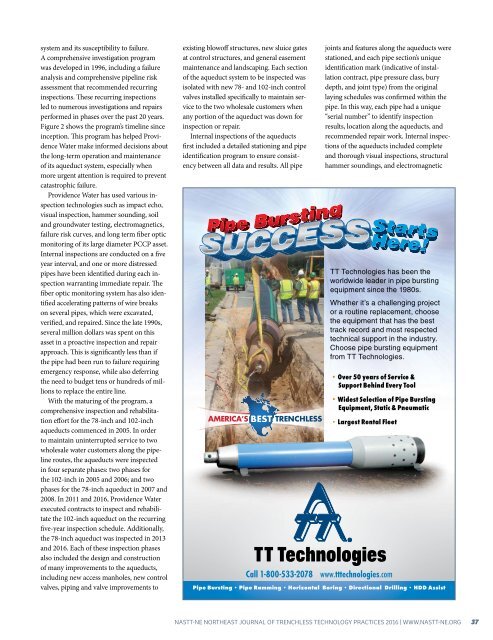PRACTICES
nastt-ne-journal-2016
nastt-ne-journal-2016
You also want an ePaper? Increase the reach of your titles
YUMPU automatically turns print PDFs into web optimized ePapers that Google loves.
system and its susceptibility to failure.<br />
A comprehensive investigation program<br />
was developed in 1996, including a failure<br />
analysis and comprehensive pipeline risk<br />
assessment that recommended recurring<br />
inspections. These recurring inspections<br />
led to numerous investigations and repairs<br />
performed in phases over the past 20 years.<br />
Figure 2 shows the program’s timeline since<br />
inception. This program has helped Providence<br />
Water make informed decisions about<br />
the long-term operation and maintenance<br />
of its aqueduct system, especially when<br />
more urgent attention is required to prevent<br />
catastrophic failure.<br />
Providence Water has used various inspection<br />
technologies such as impact echo,<br />
visual inspection, hammer sounding, soil<br />
AMERICA’S and groundwater BESTtesting, TRENCHLESS electromagnetics,<br />
failure risk curves, and long term fiber optic<br />
monitoring of its large diameter PCCP asset.<br />
Internal inspections are conducted on a five<br />
year interval, and one or more distressed<br />
pipes have been identified during each inspection<br />
warranting immediate repair. The<br />
fiber optic monitoring system has also identified<br />
accelerating patterns of wire breaks<br />
on several pipes, which were excavated,<br />
verified, and repaired. Since the late 1990s,<br />
several million dollars was spent on this<br />
asset in a proactive inspection and repair<br />
approach. This is significantly less than if<br />
the pipe had been run to failure requiring<br />
emergency response, while also deferring<br />
the need to budget tens or hundreds of millions<br />
to replace the entire line.<br />
With the maturing of the program, a<br />
comprehensive inspection and rehabilitation<br />
effort for the 78-inch and 102-inch<br />
aqueducts AMERICA’S commenced BEST TRENCHLESS in 2005. In order<br />
to maintain uninterrupted service to two<br />
wholesale water customers along the pipeline<br />
routes, the aqueducts were inspected<br />
in four separate phases: two phases for<br />
the 102-inch in 2005 and 2006; and two<br />
phases for the 78-inch aqueduct in 2007 and<br />
2008. In 2011 and 2016, Providence Water<br />
executed contracts to inspect and rehabilitate<br />
the 102-inch aqueduct on the recurring<br />
five-year inspection schedule. Additionally,<br />
the 78-inch aqueduct was inspected in 2013<br />
and 2016. Each of these inspection phases<br />
also included the design and construction<br />
of many improvements to the aqueducts,<br />
including new access manholes, new control<br />
valves, piping and valve improvements to<br />
AMERICA’S BEST TRENCHLESS<br />
AMERICA’S BEST TRENCHLESS<br />
existing blowoff structures, new sluice gates<br />
at control structures, and general easement<br />
maintenance and landscaping. Each section<br />
of the aqueduct system to be inspected was<br />
isolated with new 78- and 102-inch control<br />
valves installed specifically to maintain service<br />
to the two wholesale customers when<br />
any portion of the aqueduct was down for<br />
inspection or repair.<br />
Internal inspections of the aqueducts<br />
first included a detailed stationing and pipe<br />
identification program to ensure consistency<br />
between all data and results. All pipe<br />
AMERICA’S<br />
Starts with<br />
AMERICA’S<br />
BEST<br />
BEST<br />
TRENCHLESS<br />
TRENCHLESS<br />
joints and features along the aqueducts were<br />
stationed, and each pipe section’s unique<br />
identification mark (indicative of installation<br />
contract, pipe pressure class, bury<br />
depth, and joint type) from the original<br />
laying schedules was confirmed within the<br />
pipe. In this way, each pipe had a unique<br />
“serial number” to identify inspection<br />
results, location along the aqueducts, and<br />
recommended repair work. Internal inspections<br />
of the aqueducts included complete<br />
and thorough visual inspections, structural<br />
hammer soundings, and electromagnetic<br />
TT Technologies has been the<br />
worldwide leader in pipe bursting<br />
equipment since the 1980s.<br />
Whether it’s a challenging project<br />
or a routine replacement, choose<br />
the equipment that has the best<br />
track record and most respected<br />
technical support in the industry.<br />
Choose pipe bursting equipment<br />
from TT Technologies.<br />
• Over 50 years of Service &<br />
Support Behind Every Tool<br />
• Widest Selection of Pipe Bursting<br />
Equipment, Static & Pneumatic<br />
AMERICA’S<br />
BEST<br />
TRENCHLESS<br />
• Largest Rental Fleet<br />
Call 1-800-533-2078 www.tttechnologies.com<br />
Pipe Bursting • Pipe Ramming • Horizontal Boring • Directional Drilling • HDD Assist<br />
NASTT-NE NORTHEAST JOURNAL OF TRENCHLESS TECHNOLOGY <strong>PRACTICES</strong> 2016 | WWW.NASTT-NE.ORG 37


